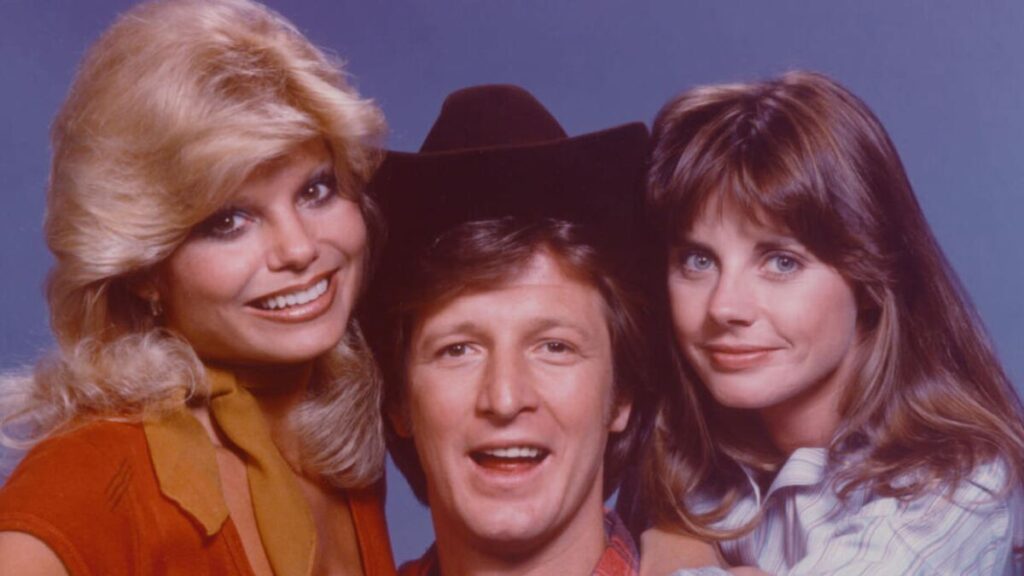When people think of Loni Anderson, it’s often the platinum blonde hair, curve-hugging dresses, and the sultry voice of Jennifer Marlowe from WKRP in Cincinnati that flash to mind. But there’s far more to her story than the sitcom stereotype. Beneath the glamour was a sharp, strategic woman who understood how to navigate Hollywood’s highs and lows—turning a fleeting moment of TV stardom into a decades-spanning career with real financial staying power.
In an industry known for its short attention spans and punishing ageism, Anderson did what many couldn’t: she adapted. She expanded her career beyond the sitcom spotlight, made savvy decisions about money, leveraged her public image on her terms, and weathered personal and professional storms with quiet resilience. Today, her estimated net worth of around $12 million isn’t just a number—it’s a reflection of smart planning, reinvention, and intentional living.
This article explores the full arc of Loni Anderson’s net worth journey: her rise to fame, smart off-screen choices, lessons in legacy-building, and how she still commands relevance in a fast-moving, youth-obsessed culture.
A Star Is Born: From Minnesota Roots to Hollywood Breakout
Early Years and the Road to Television
Long before Hollywood knew her name, Loni Anderson was a striking, self-possessed teenager growing up in the suburbs of St. Paul, Minnesota. The daughter of a model mother and a chemist father, she stood out—not just for her beauty, but for her confidence. By the time she was a high school senior, she’d been crowned Valentine Queen and voted “Most Likely to Succeed,” not for any pageant polish, but for her magnetic presence and ambition.
Loni didn’t dream small. Even as a college student studying art at the University of Minnesota, she was quietly building toward something bigger, entering beauty contests to earn tuition and landing local modelling gigs that hinted at a larger stage. But Hollywood wasn’t eager to open its doors to Midwestern brunettes—so Loni famously dyed her hair blonde, not to disappear into the mold, but to break it. She wasn’t chasing fame blindly; she was crafting her version of it—one audition, one transformation at a time.
WKRP and the Role That Changed Everything
When WKRP in Cincinnati premiered in 1978, audiences expected the usual sitcom tropes—but Loni Anderson shattered them. As Jennifer Marlowe, the station’s poised, brilliant, and stunning receptionist, she wasn’t just eye candy—she was in command. What started as a supporting role quickly became the heart of the show, earning Anderson two Emmy nominations and a Golden Globe nod.
The road to that role wasn’t instant. Rumor has it Anderson sent in a headshot so striking it stopped producers cold. Her screen test proved she had more than looks—she had timing, warmth, and a magnetic calm that upended the “dumb blonde” stereotype. At the peak of the show’s success, she was reportedly earning $50,000 per episode—serious money in late-’70s television.
But Loni knew fame could be fleeting. Even as Jennifer became a pop culture icon, she sought diverse roles in TV movies and dramas—quietly laying the groundwork to outlast her most famous character.
Wealth Behind the Glamour: Smart Career and Financial Choices
Diversifying Beyond Acting
When the WKRP spotlight dimmed, Loni Anderson didn’t vanish—she recalibrated. Rather than chase fame for fame’s sake, she leaned into roles that offered stability, visibility, and control. Throughout the ’80s and ’90s, she became a regular presence in made-for-TV movies, playing everything from real-life figures to emotionally complex mothers. These weren’t headline-grabbing parts, but they were consistent—and consistently paid.
Off-screen, Anderson showed a savvy few expected. She lent her image to carefully chosen licensing deals and public appearances that aligned with her clean, controlled brand. She also published a memoir, My Life in High Heels, not as a tell-all, but as a reflection of resilience—a move that earned both attention and royalties. And in later years, she became a sought-after speaker for lupus and COPD awareness, causes rooted in personal experience.
While many of her contemporaries faded into obscurity or financial instability, Anderson kept working—quietly, deliberately, and on her terms. Her wealth didn’t come from a single jackpot but from decades of diversification, a testament to understanding the business behind the business.
Real Estate and Lifestyle Assets
Loni Anderson has never flaunted wealth for attention—but her real estate decisions reveal a woman who values comfort, stability, and smart investment over flash. In the 1980s, she and then-husband Burt Reynolds famously owned a sprawling Mediterranean-style estate in Florida, complete with waterfalls and mirrored ceilings—a symbol of their larger-than-life pairing. But after their split, Anderson’s real estate tastes shifted toward quiet refinement.
In recent years, she’s opted for more understated luxury. A longtime resident of Southern California, she’s reportedly lived in well-appointed but modest homes in the San Fernando Valley, far from the chaos of the Hollywood Hills. Her choices suggest a preference for privacy and functionality—properties that are valuable but not ostentatious.
Rather than hoarding mansions or chasing status, Anderson appears to have prioritized homes that serve her lifestyle, not just her image. It’s a minimalist-luxe balance: enough to live comfortably and securely, but never so much that she’s trapped by maintenance or media attention. It’s yet another way she’s quietly mastered the art of lasting success.
Love, Loss, and Public Life: How Personal Events Shaped Financial Realities
High-Profile Relationships and Divorces
Loni Anderson’s marriage to Burt Reynolds in 1988 was the stuff of tabloid obsession—a golden couple, both beautiful and famous, stepping into the spotlight together. But behind the glamor, their relationship was turbulent. When it unraveled in 1993, it did so publicly and painfully, with headlines filled with accusations, interviews, and legal documents. The divorce was one of the most talked-about celebrity splits of the decade.
Financially, the fallout was significant. Though exact figures vary, Reynolds later admitted to financial difficulties, including owing Anderson unpaid support. For Loni, it meant navigating not just the end of a marriage, but a storm of scrutiny that threatened to reduce her to a headline.
But she didn’t crumble. Instead, Anderson emerged composed and focused, protecting her reputation and managing her finances independently. She refused to let the divorce define her, choosing dignity over drama. Through it all, she showed a rare strength: the ability to endure public heartbreak without sacrificing personal integrity—or long-term stability. In a business that often punishes aging women, she quietly rewrote the narrative.
Motherhood and Advocacy
For all the glitz of Loni Anderson’s public life, it’s her role as a mother that seems to have shaped her most profoundly. Her son, Quinton, whom she adopted with Burt Reynolds, was born with a range of health challenges, including a rare neurological condition. Navigating his medical needs while under constant media scrutiny required not only emotional resilience but a deep reevaluation of what truly mattered.
Anderson has spoken candidly about how motherhood changed her priorities. It wasn’t just about fame or financial success anymore—it was about stability, advocacy, and making choices that served her family. She became a dedicated supporter of health-related causes, particularly those tied to respiratory conditions, after several family members battled chronic illness. Her work with organizations like the National Lung Health Education Program and awareness campaigns for COPD wasn’t a PR move—it was personal.
Loni’s advocacy reflects a life lived with empathy. Behind the polished public image is a woman who turned personal challenges into purpose, using her platform to support others navigating similar struggles with grace and conviction.
Staying Relevant in a Youth-Obsessed Industry
Media Appearances and Public Perception
Loni Anderson never disappeared—she just evolved. Over the decades, she’s remained a familiar face through carefully chosen appearances: a red carpet here, a nostalgic TV special there, the occasional talk show moment that reminds audiences why they loved her in the first place. She’s popped up in guest roles on shows like Sabrina the Teenage Witch and So Notorious, often playing off her icon status with a wink.
She’s also faced the harsh glare of Hollywood’s expectations around aging. Rumors about plastic surgery have followed her for years, but she’s addressed them with both candor and grace—neither confirming nor denying specifics, but always emphasizing health, self-care, and personal choice.
In an industry that often sidelines women after 40, Anderson’s ability to remain present without chasing relevance is a quiet rebellion. Her image has stayed polished, but never frozen in time. She’s managed to be visible without being ubiquitous—proof that you don’t have to shout to be remembered.
Legacy Management and Public Image Strategy
Loni Anderson has done something few celebrities of her era have mastered: she’s taken charge of her legacy without clinging to past fame. Rather than constantly chasing the spotlight, she’s embraced nostalgia with intention—reuniting with WKRP castmates, participating in retrospectives, and occasionally stepping into roles that nod to her sitcom roots. It’s not about rehashing the past, but honoring it on her terms.

She’s also become increasingly selective about when and where she appears, crafting an image that’s consistent, dignified, and low-maintenance. No public meltdowns, no tabloid scandals—just the quiet authority of someone who knows who she is.
That restraint is part of her long-game net worth strategy. By managing how she’s seen, she’s preserved both public goodwill and financial value. For today’s fame-hungry culture, Anderson’s approach offers a masterclass in brand longevity: know your core identity, stay on-message, and never let the media write your final act for you.
How Loni Anderson Stacks Up Against Her Peers
With an estimated net worth of $12 million, according to celebrity net worth, Loni Anderson’s financial legacy is respectable—but perhaps more understated than some of her peers. To understand its significance, it helps to place it alongside contemporaries who shared similar levels of fame in the 1970s and ’80s, each navigating the entertainment industry in their way.
Take Suzanne Somers, for example. Known for Three’s Company, Somers turned her early sitcom success into a health and wellness empire, writing dozens of books and launching a line of fitness and beauty products. At the time of her passing in 2023, her net worth was estimated at $100 million, much of it stemming from entrepreneurship rather than acting.
Candice Bergen, another television icon known for Murphy Brown, also transitioned into film and high-paying endorsements. With a reported net worth of $50 million, her longevity came from balancing prestige projects with consistent roles.
And then there’s Farrah Fawcett, the unforgettable face of Charlie’s Angels, whose net worth at her death in 2009 was around $25 million. Despite shorter career momentum in later years, her brand value remained high due to licensing and memorabilia sales.
| Celebrity | Estimated Net Worth | Key Revenue Streams |
| Loni Anderson | $12 million | TV acting, TV movies, real estate |
| Suzanne Somers | $100 million | Acting, product lines, book deals |
| Candice Bergen | $50 million | Acting, endorsements, film |
| Farrah Fawcett | $25 million | Acting, licensing, estate value |
While Anderson may not top the list in terms of raw numbers, her steady, self-directed path underscores something different: sustainability over flash. She built a career that was less about meteoric highs and more about long-term security—a legacy grounded in consistency and control.
“What I Learned from Following Loni Anderson’s Money Moves”
As a writer who’s spent the last few years dissecting celebrity careers and the economics of fame, I’ve learned that behind every public figure is a financial story—often messier, quieter, and more revealing than what the headlines show. Loni Anderson’s net worth journey was one I initially underestimated. To be honest, I thought I’d find a familiar pattern: a peak in the ‘70s, a few missteps, and a fade into nostalgic irrelevance. But what I found instead was a blueprint for measured, intentional success.
The first surprise? Her restraint. While other stars chased every endorsement or splashy comeback, Loni made choices that aligned with her values and long-term vision. She didn’t cash in on the scandal or overplay her fame. She worked consistently, not constantly—pacing her career like a marathon, not a sprint.
Researching her reminded me that reinvention doesn’t always mean rebranding; sometimes it means refining. Loni didn’t try to be someone else as she aged—she evolved as herself. That quiet authenticity is probably why her name still resonates.
The biggest “aha” moment for me came when I looked at her post-WKRP trajectory. She didn’t try to recreate the magic. Instead, she leveraged it, branching out into TV movies, advocacy, and writing. Her financial legacy isn’t massive, but it’s hers—earned, protected, and shaped by her decisions, not public demand.
In a world that rewards flash over substance, Loni Anderson’s journey reminded me that staying power is often about knowing when not to perform. Her story isn’t just about money—it’s about knowing your worth, and protecting it like the most important role you’ll ever play.
The Enduring Allure of Loni Anderson
Loni Anderson’s net worth tells a story that goes far beyond dollars and decimal points. It’s the reflection of a career navigated with uncommon clarity—a blend of ambition, adaptability, and quiet resilience. In an industry built on reinvention, she didn’t chase reinvention for its own sake; she evolved with intention, choosing longevity over spectacle, and personal values over short-term gain.
She outlasted trends without becoming trapped by them. While others flamed out or faded quietly, Loni maintained a steady pulse in the public eye—just enough to stay relevant, never too much to become overexposed. Her decisions, both personal and professional, were often more strategic than they appeared, rooted in self-awareness and a refusal to be typecast—on screen or in life.
In today’s culture of viral fame and instant collapse, Anderson’s legacy feels more relevant than ever. She proves that a lasting career—and a meaningful financial life—doesn’t come from chasing the spotlight, but from learning when to step out of it. Her allure isn’t just in who she was, but in how she stayed true to herself, decade after decade.
Mohit Wagh is the co-founder of The Graval with over 10 years of experience in SEO and content strategy. He specializes in crafting data-driven, authoritative content that blends cultural insight with digital growth.





4 thoughts on “Loni Anderson’s Net Worth Journey: TV Stardom, Smart Moves, and Staying Power”